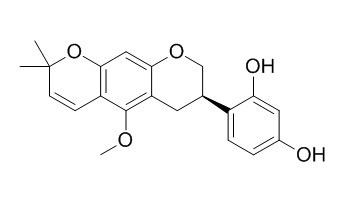Neorauflavane
Neorauflavane shows tyrosinase inhibition, it can inhibit tyrosinase monophenolase activity with an IC50 of 30 nM, it also can efficiently reduce melanin content in B16 melanoma cells with 12.95 uM of IC50.
Inquire / Order:
manager@chemfaces.com
Technical Inquiries:
service@chemfaces.com
Tel:
+86-27-84237783
Fax:
+86-27-84254680
Address:
1 Building, No. 83, CheCheng Rd., Wuhan Economic and Technological Development Zone, Wuhan, Hubei 430056, PRC
Providing storage is as stated on the product vial and the vial is kept tightly sealed, the product can be stored for up to
24 months(2-8C).
Wherever possible, you should prepare and use solutions on the same day. However, if you need to make up stock solutions in advance, we recommend that you store the solution as aliquots in tightly sealed vials at -20C. Generally, these will be useable for up to two weeks. Before use, and prior to opening the vial we recommend that you allow your product to equilibrate to room temperature for at least 1 hour.
Need more advice on solubility, usage and handling? Please email to: service@chemfaces.com
The packaging of the product may have turned upside down during transportation, resulting in the natural compounds adhering to the neck or cap of the vial. take the vial out of its packaging and gently shake to let the compounds fall to the bottom of the vial. for liquid products, centrifuge at 200-500 RPM to gather the liquid at the bottom of the vial. try to avoid loss or contamination during handling.
Evid Based Complement Alternat Med.2021, 8855980.
Food Chem.2019, 274:345-350
Clin Transl Oncol.2019, 10.1007
J Cell Physiol.2020, 10.1002
Nutrients.2019, 11(6):E1380
Phytomedicine.2021, 93:153796.
Reprod Toxicol.2020, 96:1-10.
Daru.2024, 32(2):689-703.
Front. Plant Sci.2022, 13:757852.
LWT2024, v208:116677
Related and Featured Products
Bioorg Med Chem. 2016 Jan 15;24(2):153-9.
Highly potent tyrosinase inhibitor, neorauflavane from Campylotropis hirtella and inhibitory mechanism with molecular docking.[Pubmed:
26706112 ]
Tyrosinase inhibition may be a means to alleviate not only skin hyperpigmentation but also neurodegeneration associated with Parkinson's disease.
METHODS AND RESULTS:
In the course of metabolite analysis from tyrosinase inhibitory methanol extract (80% inhibition at 20 μg/ml) of Campylotropis hirtella, we isolated fourteen phenolic compounds, among which Neorauflavane 3 emerged as a lead structure for tyrosinase inhibition. Neorauflavane 3 inhibited tyrosinase monophenolase activity with an IC50 of 30 nM. Thus this compound is 400-fold more active than kojic acid. It also inhibited diphenolase (IC50=500 nM), significantly. Another potent inhibitor 1 (IC50=2.9 μM) was found to be the most abundant metabolite in C. hirtella. In kinetic studies, compounds 3 showed competitive inhibitory behavior against both monophenolase and diphenolase. It manifested simple reversible slow-binding inhibition against monophenolase with the following kinetic parameters: Ki(app)=1.48 nM, k3=0.0033 nM(-1) min(-1) and k4=0.0049 min(-1). Neorauflavane 3 efficiently reduced melanin content in B16 melanoma cells with 12.95 μM of IC50.
CONCLUSIONS:
To develop a pharmacophore model, we explored the binding mode of neuroflavane 3 in the active site of tyrosinase. Docking results show that resorcinol motif of B-ring and methoxy group in A-ring play crucial roles in the binding the enzyme.



